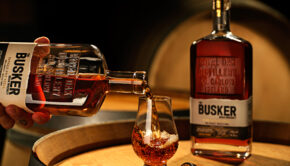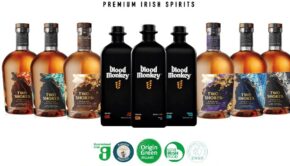Drinks exports down 19% in 2020

In response to Bord Bia's exports report, Drinks Ireland has released its industry outlook for 2021
19 January 2021
A new report by Bord Bia, ‘Export Performance and Prospects 2020/21’, confirmed that US tariffs and Brexit stockpiling, along with closures and restrictions on hospitality outlets globally due to the Covid-19 pandemic, negatively impacted drinks exports last year, which fell by 19% to €1.3 billion. Industry group Drinks Ireland said that in addition to exports, Covid-19 also significantly impacted production and domestic sales in 2020.
According to the Bord Bia report, however, the value of alcohol exports last year remained 12% higher than they were pre-Brexit in 2016, highlighting the growth the industry has undergone in recent years and its strength on the global stage.
Additionally, it notes that declines in exports do not necessarily reflect a decline in sales, as a significant volume of Irish spirits was in place in the US market at the start of 2020, for example, in the context of ongoing US-EU tariff disputes, which have threatened the extension of tariffs on spirits in both directions.
“Ireland’s drinks industry is dynamic, innovative, and has performed strongly in domestic and export markets in recent years,” said Patricia Callan, director of Drinks Ireland.
Callan said she is confident the sector can regain some growth, but that “recovery is dependent on a number of factors and supports from government, including the full sustained reopening of the hospitality sector, a rebound in international tourism for visitor centres, and supports for Irish drinks exports.”
In response to the Bord Bia report, Drinks Ireland has released its industry outlook for 2021, stating that drinks producers will be focused on driving recovery this year.
Here is Drinks Ireland’s outlook for the sector:
- 2019 will be the ‘benchmark’ for the drinks industry
Prior to Covid-19, the drinks industry was experiencing strong growth, which it will be seeking to regain. Looking at exports, for example, according to the Bord Bia report, in the four years since 2016, there was €140m of growth in the value of alcohol exports. 58% of that growth was to EU27, and 41% to North America.
- Recovery in the domestic market will require the full hospitality sector to be reopened
A safe and sustained reopening of the full hospitality sector as soon as possible, including traditional pubs that don’t serve food, will be vital for Ireland’s drinks industry. This recovery in the domestic market will require a revised plan for really living with Covid, alongside a speedy rollout of the vaccination programme.
- Regaining growth in export markets will be vital
While exports were hit last year, they remained strong, and Drinks Ireland said that supporting brands to recover and regain market position and share should be a key priority for Government this year. Funding ‘boots on the ground’ through brand ambassador placements in markets around the world has long been the key to Irish food and drinks export success and will be more vital than ever.
- Alcohol consumption will continue to decline in Ireland
The closure of the hospitality sector resulted in alcohol consumption declining in 2020, with Revenue clearance data showing that it fell by 4.5% between January and September 2020, compared to the same period in 2019.
While the sector will aim to recover from the impact of Covid-19 this year, it anticipates that the long-term trend of consumption declining, and consumers choosing “quality over quantity” will continue. Since 2001, the average per adult alcohol consumption has fallen by 23.2% in Ireland according to CSO and Revenue Data.
- A restart of international tourism will support visitor centres
Irish drinks visitor attractions in this state are highly dependent (90%) on international visitors. Drinks-based visitor attractions, similar to the rest of the domestic tourism sector will be dependent in the short-term on the maximisation of domestic tourism. It will innovate to attract new types of visitors and will move to add value with smaller group, more bespoke, higher end experiences on offer. As international travel opens up to a greater extent in 2021, the industry will also be looking to increase footfall from visitors from abroad.
- Meeting the demands of a changing drinks consumer
As the sector works to regain growth at home and in export markets, it will continue to focus on meeting the needs of the changing drinks consumer through innovation.
- In the beer sector, low and non-alcoholic options are becoming more popular, and non-alcoholic beer now accounts for 1% of Ireland’s beer market.
- There is a growing demand for high-quality spirits products like Irish gin and Irish whiskey, with domestic sales of spirits growing by 0.7%, from 2.4 million to 2.42 million nine-litre cases, between 2018 and 2019.
- Hard seltzers will grow significantly from being a new market entrant last year, with many new brands set to land on the shelves in 2021.
- The Irish cider industry has innovated significantly in recent years, which has reinvigorated the market and resulted in more choice than ever for Irish cider consumers.
- In terms of wine, sales of rosé grew in 2019, and the summer favourite now accounts for just under 6% of all wine consumed here, up from 3% in 2019.
- Drinks industry to continue driving forward sustainability agenda
Irish drinks producers will continue to push forward the sustainability agenda this year, as many companies have ambitious targets for 2021 and beyond. Looking at Irish brewers, for example, in recent years they have started to repurpose grain for beer into livestock feed, have achieved zero waste to landfill at production sites and offices, and are using more recyclable material for packaging.
- Growth of Irish whiskey industry will drive more rural development and inner-city regeneration
The drinks industry supports the domestic economy and jobs across Ireland, including in more rural locations where producers are located.
Many of Ireland’s whiskey distilleries in provincial towns have moved into vacant industrial premises, replacing the enterprises that had previously operated there, as well as lost jobs. This trend looks set to continue, with more developments planned. Similarly, in less rural settings the development of distilleries in Dublin has played a pivotal role in kick-starting the urban regeneration of areas in the city.
- E-Commerce set to grow as a route to market
2020 saw substantial growth in drinks online sales in Ireland and globally. The rise of e-commerce offers opportunities for Irish producers to break into new markets and reach new consumer segments and this will only grow in 2021. Last year saw widespread innovation in online marketing and consumer engagement, with increasing numbers of online tasting events. This is a trend that’s here to stay.
- Other challenges ahead, including Brexit & US Tariffs
Outside of Covid-19, the industry also faces a number of other challenges. While the industry welcomed a deal being reached, there are increased costs and compliance burdens associated with Brexit. The Bord Bia report notes, however, that alcohol has been one of the most successfully diversified categories and has one of the lowest dependency rates on the UK market of any major food and drink category with just 15% of exports destined for that market. The spirits sector has also been impacted by the ongoing trade disputes between the US and the European Union.



 Print
Print






Fans 0
Followers